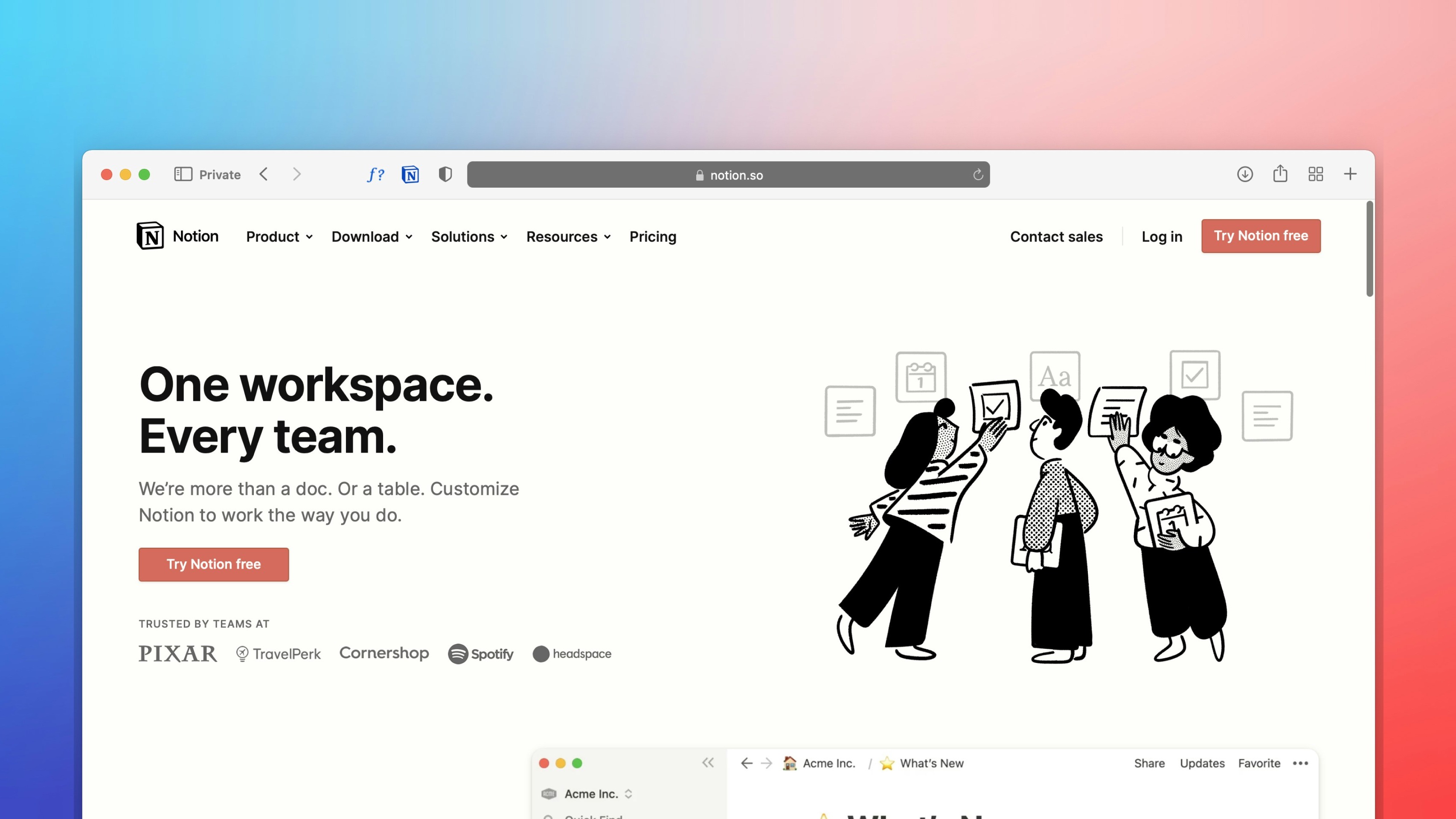 Freelancer tips
Freelancer tips Notion: What It Is, What It’s For, and How to Use It in Your Daily Life
Want to better organize your life and work? Notion can help boost your productivity. Click here to discover what this software is and what it’s used for.



Client prospecting isn’t just a one-off task; it’s a skill that shapes the growth and stability of your freelance business. Identifying the right clients and connecting with them is essential for building solid, long-term commercial relationships—something vital to boosting your profits.
Want to thrive as a freelancer?
Discover how to prospect clients in this post. Besides giving you a broader definition, we’ll share the tools you need to become a prospecting pro.
It’s the process of identifying and attracting potential clients who might need the products or services you offer. The goal is to make first contact with people or companies matching the profile of your ideal customer—essential for forging long-term commercial relationships and generating new business opportunities.
A prospect is basically a “lead” in marketing terms—a contact who could become a future client. It’s a crucial stage in the sales cycle since it helps broaden your client base and raise revenue.
There are two primary approaches:
Contacting individuals or companies unfamiliar with your product/service yet. Indeed, it can be challenging, so patience and persistence are key. Still, it’s a necessary approach to show them solutions that might interest them.
What is warm client prospecting?
It’s reaching out to individuals or companies that have already shown interest in your offerings—like someone who found your brand on social media or got referred by someone. Here, your goal is to finalize the sale as soon as possible before they lose interest or opt for someone else. You must be agile and transparent in offering all the needed details and stay persistent so you can close the sale—without being pushy.
In short, warm prospecting targets folks who know you, while cold prospecting focuses on strangers.
After clarifying what “prospecting” means, it’s essential to master these four foundational stages before implementing a strategy:
The first step is to locate your ideal consumers, applying one of these prospecting types:
Inbound
Outbound
Channels
Mixed
Referrals
For example, you might choose passive prospecting (Inbound), where leads come from digital marketing tactics—simpler than active prospecting (Outbound). In the latter, you look for clients who still don’t know your brand or its benefits.
Beyond building a prospect list, you need to research their needs, challenges, and how your product or service might solve them. Social networks—like Instagram or LinkedIn—are excellent tools to learn about your leads before you approach them.
That’s why many freelancers leverage LinkedIn for remote work.
The next stage is initial outreach to the company/person. You can do this by:
Cold calls
Events
Cold emailing
Social media, etc.
Balance your approach so you don’t come off too pushy or too aloof.
Early on, you’ll check whether this lead actually fits your business. You want to ask the right questions to assess:
Their purchasing power or budget
Needs
Decision-making authority
Past experiences with other providers
All four steps are crucial for any freelancer who wants to master client prospecting, as each has its own essential goal.
Prospecting is essential to get more clients and grow any business you have. The good news is that there are always effective strategies you can put into practice.
Here are 5 tactics that will help you do just that:
Start by getting to know your potential customers well, so the rest of your tactics are correctly targeted. That means looking at the company/individual, their industry, and their needs. With these details, you can figure out how to best demonstrate the value you offer.
In the digital era, social platforms are hugely important for prospecting. In fact, they’re an ideal lead-generation tool via “social selling” strategies. Almost 5 billion people use social media worldwide, meaning you have massive reach for gaining leads.
They’re also incredibly useful for those in marketing. Taking a look at Statista’s 2024 ranking, Facebook and Instagram lead the pack, with LinkedIn in third place.
Initiating a conversation with a stranger can be tricky. Even though you must be clear and persuasive, your approach should also be natural and spark interest—akin to starting a casual conversation. For instance, crafting an elevator pitch is an excellent idea: a short, direct, and engaging message that grabs the client’s attention right from the start.
Client Relationship Management (CRM) software is another great way to help with client prospecting—organizing and identifying leads and keeping track of interactions so you can boost efficiency. Among the many tools out there, Salesforce and HubSpot are known for their reputations.
Follow-ups matter as much as first contact:
Confirm the lead received your message.
Gauge their level of interest.
Figure out where they stand in the overall process.
Maintain a thoughtful follow-up plan to strengthen their interest and steer them toward a sale or contract.
Successful prospecting is all about reaching the right audience—and not pouring resources into leads lacking interest or demand.
A few practical pointers:
Focus on leads who have the greatest potential to buy your product/service and keep nurturing those who are still undecided.
Even after a client is secured, continue sending them updates, valuable content, and messages so you stay on their radar.
Offer specific dates and times for showcasing your solutions.
Realize most people won’t say yes right away—you’ll need persistence, but don’t go overboard.
Determine the best time of day to send proposals or follow up.
Ultimately, your ability to research, filter, and connect with leads matching your ideal customer profile is essential. If it doesn’t work at first, tweak your strategy and keep at it.
Prospecting is a balancing act of strategy and empathy—yet we’re all prone to errors that can affect outcomes. Here are five common ones, plus how to sidestep them:
1. Failure to Research. Sending generic messages just turns prospects away, lowering your success rate. It’s crucial to spend time gathering relevant info so you can personalize your outreach effectively.
2. Not Recognizing Disinterest. Over-pursuing a lead who shows zero interest wastes resources. Know when to step back and redirect your energy toward those who do care.
3. Dropping the Ball After the First Contact. A majority of prospects require multiple interactions before committing. Stay consistent (but not pushy).
4. Pushing the Sale Over the Relationship. Build trust first. A sincere approach that focuses on the client fosters stronger, longer-lasting results.
5. Forgetting to Ask for Feedback. Rejections can provide lessons and help adjust your strategy. Always ask how you can improve.
Although these errors are widespread, you can learn from them to turn a missed opportunity into a future success.
With these ideas about client prospecting in mind, here’s a step-by-step approach:
Outline your ideal client by answering:
Who are they?
What problems do they face?
Which digital platforms do they use?
This helps you spot high-quality leads.
If you have multiple leads, categorize them because no two are the same. Group them by sector, needs, or behavior—whatever helps you shape more relevant messages.
Score your prospects based on how they engage with your brand (visits to your site, or content downloads, for example). Prioritize the ones most likely to convert and nurture the rest with valuable content to keep them interested.
Align your outreach with your audience’s demographic features. Every channel has a distinct style, so what works on LinkedIn may not fly on Instagram. Tailor your message to each space.
If a lead shows interest but fails to move forward, figure out what held them back. Then use a subtle approach to rekindle their interest—but avoid being pushy.
Any freelancer should grasp what prospecting is to develop a profitable business. Thorough research, effective lead segmentation, and relevant technology can make a notable difference. Plus, establishing relationships built on trust is the key to getting positive testimonials from clients.
Working freelance with foreign companies or clients?
We suggest downloading DolarApp and seeing for yourself how it can simplify handling international earnings. The app can help you manage digital dollars from Mexico, Argentina, or Colombia, meaning you can get paid into a U.S. account fast—and save in digital dollars.
Once you’re ready to convert them to pesos, just link a local account. The process is straightforward, fee-free, and we offer a fair exchange rate.

The world has borders. Your finances don’t have to.
 Freelancer tips
Freelancer tips Want to better organize your life and work? Notion can help boost your productivity. Click here to discover what this software is and what it’s used for.

 Freelancer tips
Freelancer tips Project chaos? Learn how Trello can help you organize tasks and improve your productivity.

 Freelancer tips
Freelancer tips ClickUp can make any freelancer more productive. Discover what it is, how it works, and the advantages this tool offers you


